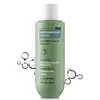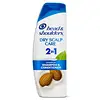What's inside
What's inside
 Key Ingredients
Key Ingredients

No key ingredients
 Benefits
Benefits

 Concerns
Concerns

 Ingredients Side-by-side
Ingredients Side-by-side

Water
Skin ConditioningSodium Lauroyl Methyl Isethionate
CleansingCocamidopropyl Betaine
CleansingPropanediol
SolventDimethiconol
EmollientGlycerin
HumectantTea-Dodecylbenzenesulfonate
CleansingAcrylates Copolymer
Parfum
MaskingPiroctone Olamine
PreservativeSalicylic Acid
MaskingEpilobium Angustifolium Extract
Skin ConditioningPanthenol
Skin ConditioningRosmarinus Officinalis Leaf Extract
AntimicrobialNasturtium Officinale Extract
PerfumingSalvia Officinalis Leaf Extract
CleansingNiacin
SmoothingBiotin
AntiseborrhoeicAloe Barbadensis Leaf Extract
EmollientMenthol
MaskingMilk Protein
Skin ConditioningStearamidopropyl Dimethylamine
EmulsifyingGlycol Stearate
EmollientGuar Hydroxypropyltrimonium Chloride
Skin ConditioningMica
Cosmetic ColorantTitanium Dioxide
Cosmetic ColorantTin Oxide
AbrasivePEG-45m
HumectantSodium Chloride
MaskingCitric Acid
BufferingPhenoxyethanol
PreservativeSodium Benzoate
MaskingDisodium EDTA
Water, Sodium Lauroyl Methyl Isethionate, Cocamidopropyl Betaine, Propanediol, Dimethiconol, Glycerin, Tea-Dodecylbenzenesulfonate, Acrylates Copolymer, Parfum, Piroctone Olamine, Salicylic Acid, Epilobium Angustifolium Extract, Panthenol, Rosmarinus Officinalis Leaf Extract, Nasturtium Officinale Extract, Salvia Officinalis Leaf Extract, Niacin, Biotin, Aloe Barbadensis Leaf Extract, Menthol, Milk Protein, Stearamidopropyl Dimethylamine, Glycol Stearate, Guar Hydroxypropyltrimonium Chloride, Mica, Titanium Dioxide, Tin Oxide, PEG-45m, Sodium Chloride, Citric Acid, Phenoxyethanol, Sodium Benzoate, Disodium EDTA
Zinc Pyrithione 1%
AntiseborrhoeicDimethiconol
EmollientWater
Skin ConditioningDimethicone
EmollientSodium Laureth Sulfate
CleansingSodium Benzoate
MaskingSodium Lauryl Sulfate
CleansingGuar Hydroxypropyltrimonium Chloride
Skin ConditioningCocamidopropyl Betaine
CleansingTea-Dodecylbenzenesulfonate
CleansingSodium Xylenesulfonate
Trideceth-10
CleansingZinc Carbonate
Magnesium Carbonate Hydroxide
BufferingGlycol Distearate
EmollientPrunus Amygdalus Dulcis Oil
Skin ConditioningParfum
MaskingBenzyl Alcohol
PerfumingSodium Chloride
MaskingMethylchloroisothiazolinone
PreservativeMethylisothiazolinone
PreservativeZinc Pyrithione 1%, Dimethiconol, Water, Dimethicone, Sodium Laureth Sulfate, Sodium Benzoate, Sodium Lauryl Sulfate, Guar Hydroxypropyltrimonium Chloride, Cocamidopropyl Betaine, Tea-Dodecylbenzenesulfonate, Sodium Xylenesulfonate, Trideceth-10, Zinc Carbonate, Magnesium Carbonate Hydroxide, Glycol Distearate, Prunus Amygdalus Dulcis Oil, Parfum, Benzyl Alcohol, Sodium Chloride, Methylchloroisothiazolinone, Methylisothiazolinone
 Reviews
Reviews

Ingredients Explained
These ingredients are found in both products.
Ingredients higher up in an ingredient list are typically present in a larger amount.
Cocamidopropyl Betaine is a fatty acid created by mixing similar compounds in coconut oil and dimethylaminopropylamine, a compound with two amino groups.
This ingredient is a surfactant and cleanser. It helps gather the dirt, pollutants, and other impurities in your skin to be washed away. It also helps thicken a product and make the texture more creamy.
Being created from coconut oil means Cocamidopropyl Betaine is hydrating for the skin.
While Cocamidopropyl Betaine was believed to be an allergen, a study from 2012 disproved this. It found two compounds in unpure Cocamidopropyl Betaine to be the irritants: aminoamide and 3-dimethylaminopropylamine. High-grade and pure Cocamidopropyl Betaine did not induce allergic reactions during this study.
Learn more about Cocamidopropyl BetaineDimethiconol is a silicone that resembles the popular dimethicone. Like other silicones, it is an emollient. Emollients create a thin film on skin to prevent moisture from escaping.
This ingredient helps to create a silky texture and improve spreadability. Due to its high molecular weight and thickness, it is often combined with cyclopentasiloxane.
This ingredient is derived from guar gum.
It is a conditioning ingredient, meaning it helps soften skin and hair.
Parfum is a catch-all term for an ingredient or more that is used to give a scent to products.
Also called "fragrance", this ingredient can be a blend of hundreds of chemicals or plant oils. This means every product with "fragrance" or "parfum" in the ingredients list is a different mixture.
For instance, Habanolide is a proprietary trade name for a specific aroma chemical. When used as a fragrance ingredient in cosmetics, most aroma chemicals fall under the broad labeling category of “FRAGRANCE” or “PARFUM” according to EU and US regulations.
The term 'parfum' or 'fragrance' is not regulated in many countries. In many cases, it is up to the brand to define this term.
For instance, many brands choose to label themselves as "fragrance-free" because they are not using synthetic fragrances. However, their products may still contain ingredients such as essential oils that are considered a fragrance by INCI standards.
One example is Calendula flower extract. Calendula is an essential oil that still imparts a scent or 'fragrance'.
Depending on the blend, the ingredients in the mixture can cause allergies and sensitivities on the skin. Some ingredients that are known EU allergens include linalool and citronellol.
Parfum can also be used to mask or cover an unpleasant scent.
The bottom line is: not all fragrances/parfum/ingredients are created equally. If you are worried about fragrances, we recommend taking a closer look at an ingredient. And of course, we always recommend speaking with a professional.
Learn more about ParfumSodium Benzoate is a preservative. It's used in both cosmetic and food products to inhibit the growth of mold and bacteria. It is typically produced synthetically.
Both the US FDA and EU Health Committee have approved the use of sodium benzoate. In the US, levels of 0.1% (of the total product) are allowed.
Sodium benzoate works as a preservative by inhibiting the growth of bacteria inside of cells. It prevents the cell from fermenting a type of sugar using an enzyme called phosphofructokinase.
It is the salt of benzoic acid. Foods containing sodium benzoate include soda, salad dressings, condiments, fruit juices, wines, and snack foods.
Studies for using ascorbic acid and sodium benzoate in cosmetics are lacking, especially in skincare routines with multiple steps.
We always recommend speaking with a professional, such as a dermatologist, if you have any concerns.
Learn more about Sodium BenzoateChances are, you eat sodium chloride every day. Sodium Chloride is also known as table salt.
This ingredient has many purposes in skincare: thickener, emulsifier, and exfoliator.
You'll most likely find this ingredient in cleansers where it is used to create a gel-like texture. As an emulsifier, it also prevents ingredients from separating.
There is much debate on whether this ingredient is comedogenic. The short answer - comedogenic ratings don't tell the whole story. Learn more about comegodenic ratings here.
The concensus about this ingredient causing acne seems to be divided. Research is needed to understand if this ingredient does cause acne.
Scrubs may use salt as the primary exfoliating ingredient.
Learn more about Sodium ChlorideWe don't have a description for Tea-Dodecylbenzenesulfonate yet.
Water. It's the most common cosmetic ingredient of all. You'll usually see it at the top of ingredient lists, meaning that it makes up the largest part of the product.
So why is it so popular? Water most often acts as a solvent - this means that it helps dissolve other ingredients into the formulation.
You'll also recognize water as that liquid we all need to stay alive. If you see this, drink a glass of water. Stay hydrated!
Learn more about Water